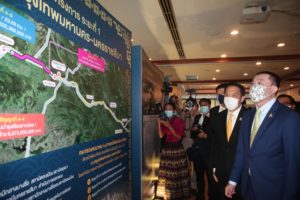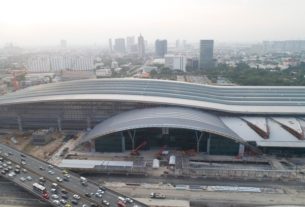
Calls to speed up Thailand’s rail link to Laos-China line
The government is being advised to speed up the development of a rail network linking Thailand’s rail system with the Laos-China Railway, which connects Kunming in China’s Yunnan province with Vientiane — the capital of Laos.
Danucha Pichayanan, secretary-general of the National Economic and Social Development Council (NESDC), said the government needs to accelerate conducting an agreement with its Lao and Chinese counterparts to build a seamless linkage between Thailand’s rail system and the Laos-China Railway.
The Laos-China railway is the first railway project built with Chinese investment, jointly operated by China and Laos and directly connected to China’s railway network.
The railway is a docking project between the China-proposed Belt and Road Initiative and Laos’ strategy to convert itself from a landlocked country to a land-linked hub.
The electrified passenger and cargo railway is built with the full application of Chinese management and technical standards. The construction of the project started in December 2016 and is scheduled to be completed and open to traffic on Dec 3, 2021.
The economic and trade impact of the Laos-China Railway is expected to be substantial.
The cost of shipments from Vientiane to Kunming in the southern Chinese province of Yunnan will be cut by 40-50% or US$30 per tonne, along with a 20-40% cost reduction on domestic routes, according to a World Bank report “From landlocked to land-linked: unlocking the potential of Lao-China rail connectivity”.
Exports from Laos to China were worth $1.7 billion in 2019 and could expand by about 20% per year, a report by UN Comtrade has said.
The governments of Laos and China have also signed an agreement for China to import more goods from Laos, especially agricultural products such as corn, bananas, cassava and beans, beef and other products, by shipping to Yunnan.
The rail link will also attract more investments from China and other countries, mainly in agriculture, livestock and mining.
China is by far the top source of foreign direct investment (FDI) in Laos, accounting for 87.7% of cumulative FDI flows into the country or $967.7 million as of the end of 2020.
Investors from Thailand and Vietnam were second and third with shares of 4.9% and 2.5%, respectively.
More investments from China will be drawn to sites in Laos along the rail line, particularly in special economic zones (SEZs), for products to be manufactured in Laos and sent to China for export via the rail network that now stretches from China to Europe.
Thailand’s leading industrial estate developer, Amata Corporation, has won approval from Vientiane to develop a large-scale SEZ in northern Laos.
Laos-China railway will also increase the number of tourists, especially from China, as it will significantly reduce travel time.
Prior to the pandemic, Laos was attracting between 800,000 and one million tourists a year from China, and the figure is projected to expand by 40-50% once international travel resumes, said Soulivath Souvannachoumkham, director-general of the External Finance and Debt Management Department at the Ministry of Finance.
Currently, logistics and travel between Thailand and Laos are facilitated via the one-metre gauge track rail linking Thailand’s Nong Khai and Tha Na Laeng station in Vientiane.
Thailand’s Neighbouring Countries Economic Development Cooperation Agency (Neda) has already supported the construction of a one-metre gauge track of 5.35 kilometres in length linking Tha Na Laeng station to northern Vientiane. The project is 70% complete.
However, there is still a missing link between the existing rail system and the Laos-China Railway which is located in southern Vientiane.
Mr Danucha proposed the Thai government speed up a tripartite agreement to develop seamless logistics infrastructure between Thailand and the China-Laos Railway, saying Thailand is also developing connectivity to the flagship Eastern Economic Corridor and related projects such as inland container depots or dry ports.
“Thailand may lose an opportunity to boost trade, investment and tourism if the country ignores speeding up forming an agreement with China and Laos,” he said.
“Better or seamless rail linkage will enhance economic opportunity and expansion of trade, investment and tourism between Thailand, Laos and China.”
Source: https://www.bangkokpost.com/business/2224707/calls-to-speed-up-link-to-laos-china-line



